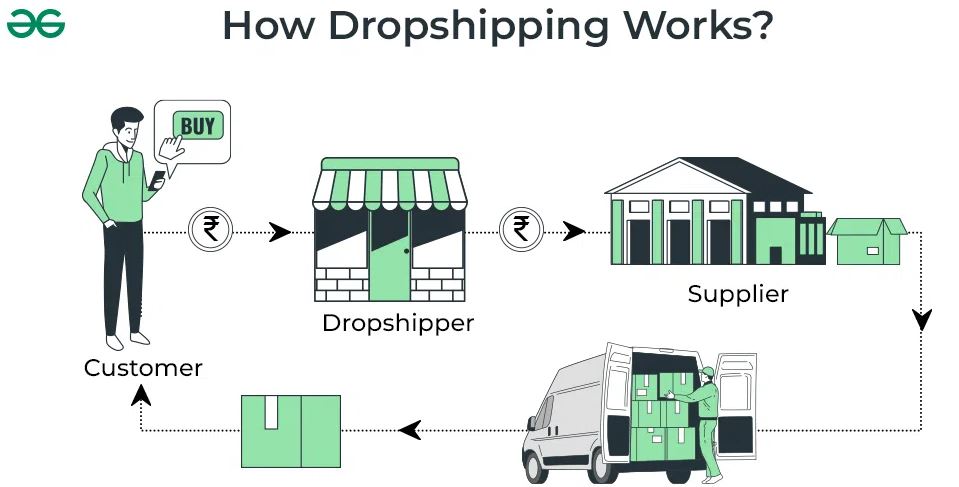What is dropshipping?
Dropshipping is a retail fulfillment method in which a store sells things without keeping them in stock. Instead, when a store sells a product, it buys it from a third party and ships it directly to the consumer. In essence, the seller serves as a liaison between the supplier and the buyer, never handling the product directly. This business model has various advantages, especially for entrepreneurs wishing to launch an e-commerce enterprise with a low initial cost. One of the key benefits of dropshipping is the low barrier to entry; because you don’t have to invest in inventory or run a warehouse, the initial capital required is substantially smaller than for traditional retail operations. Dropshipping also provides greater flexibility and scalability because you can easily add or remove products from your online store without having to worry about physical inventory. However, it is critical to acknowledge the inherent challenges of dropshipping, such as fierce rivalry, dependency on third-party suppliers, and potentially reduced profit margins due to increasing competition and supplier prices. Despite these limitations, dropshipping remains a popular and feasible choice for ambitious entrepreneurs looking to break into the e-commerce market. With careful planning, clever product selection, and efficient marketing, dropshipping can be a viable and long-term business model.
[adinserter block=”1″]
How Does Drop Shipping Work?
Dropshipping works on a simple principle. First, the retailer creates an online store that displays products received from vendors or wholesalers. When a customer puts a purchase through the retailer’s website, the retailer sends the order data and payment to the supplier, generally at a wholesale price. The supplier then ships the product directly to the buyer, bypassing the store completely. This technique reduces the retailer’s need to manage inventory, storage space, or order fulfillment, as those obligations are delegated to the supplier. From the customer’s perspective, the experience is seamless—they explore products, make a buy, and receive their order without realizing that the store is not actually handling the merchandise. This strategy has several advantages, including inexpensive beginning costs, limited inventory risk, and the ability to operate from any location with an internet connection. However, successful dropshipping necessitates meticulous planning, which includes identifying dependable suppliers, optimizing product selection, and implementing efficient marketing methods to bring visitors to the online store. Despite its simplicity, dropshipping necessitates meticulous attention to detail and a dedication to offering exceptional customer service in order to retain a favorable reputation and create long-term success in the competitive e-commerce industry.
Advantages of dropshipping
Dropshipping provides numerous benefits for enterprises starting into the world of e-commerce. One of the most major advantages is the low initial expenditure required to establish a dropshipping business. Unlike typical retail methods, which need significant cash for inventory procurement and storage, dropshipping reduces this burden by eliminating the need to purchase inventory upfront. This reduces financial risk for ambitious business owners, as they can establish their online store with a minimum initial expenditure. Furthermore, dropshipping provides exceptional flexibility and scalability. Entrepreneurs may effortlessly add or remove products from their store without having to worry about physical inventory, allowing them to quickly adjust to shifting market trends and client preferences. Additionally, dropshipping allows for location freedom because the entire operation can be controlled remotely with only a laptop and an internet connection. This freedom allows entrepreneurs to run their firms from anywhere in the globe, giving flexibility and autonomy that traditional brick-and-mortar enterprises frequently lack. Furthermore, dropshipping simplifies order fulfillment and logistics by having suppliers handle inventory management, packing, and shipping. This streamlined approach frees up significant time and resources, allowing entrepreneurs to focus on key business tasks like marketing, customer service, and brand growth. Overall, the benefits of dropshipping make it an appealing alternative for individuals looking to enter the e-commerce business with low risk and high potential for growth and success.
[adinserter block=”1″]
Disadvantages of Drop Shipping
While dropshipping has many benefits, it is critical to recognize the inherent limitations and challenges involved with this business model. One major downside is a lack of control over inventory and fulfillment procedures. Because the store relies on third-party suppliers to manage inventories and fulfill orders, they have little insight and control over product availability, quality, and delivery schedules. This can result in difficulties like stockouts, backorders, and delayed shipping, all of which can reduce consumer happiness and damage brand trust. Furthermore, dropshipping frequently results in lower profit margins than traditional retail models, as merchants must acquire products from suppliers at wholesale pricing, leaving them with narrower profit margins after accounting for marketing charges, transaction fees, and other overhead costs. Furthermore, the fierce rivalry in the dropshipping market might make it difficult for retailers to stand out and attract clients in a sea of similar products and stores. Furthermore, relying on third-party suppliers increases risk since retailers are subject to supplier errors, inventory shortages, and unexpected changes in product availability or pricing. Finally, because the store is not involved in the fulfillment process, they may have little control over product quality or ensuring that orders are properly wrapped and sent, thus leading to customer discontent and poor reviews. Despite these obstacles, with careful planning, strategic alliances, and a focus on customer experience, entrepreneurs may overcome the disadvantages of dropshipping and establish a successful and sustainable e-commerce business.
Find Dropshipping Suppliers
Finding trustworthy dropshipping suppliers is a critical step toward establishing a successful dropshipping business. One of the most successful ways to locate suppliers is through internet directories and marketplaces that connect retailers with wholesalers and dropshippers. Platforms like as Alibaba, SaleHoo, and Oberlo provide comprehensive databases of suppliers from a variety of industries, allowing retailers to explore and compare options based on product selection, pricing, and delivery terms. Furthermore, visiting trade exhibitions and industry events can give excellent networking opportunities with potential suppliers, allowing merchants to make personal relationships and negotiate better terms. Another option is to contact manufacturers and distributors in your field via email or phone, enquiring about their dropshipping policies and needs. It is critical to thoroughly investigate potential suppliers to verify they are respectable, trustworthy, and capable of meeting your company’s needs. This includes looking into their track record, reading reviews and testimonials from other sellers, and getting samples to assess product quality firsthand. Furthermore, communication is critical to developing a great connection with suppliers, thus keeping open and transparent communication channels is crucial for addressing any issues or concerns that may occur. Retailers who invest time and effort in selecting credible dropshipping providers can set the groundwork for a profitable and sustained e-commerce business.
[adinserter block=”1″]
Selecting Products for Dropshipping
Selecting the correct products for dropshipping is important to the success of your e-commerce business. The objective is to discover products that meet market demand, have competitive profit margins, and differentiate your store from competitors. Begin by conducting extensive market research to uncover popular products, specialty markets, and customer preferences. To enhance your sales potential, seek out products with constant demand and a large target audience. Consider product pricing, delivery expenses, and the opportunity to upsell or cross-sell complementary items. It is also critical to monitor competition and market saturation in order to avoid entering congested niches where it may be difficult to stand out. Furthermore, prioritize products from dependable suppliers who can regularly supply high-quality products and fast shipping, ensuring a positive client experience. Don’t underestimate the power of product branding and presentation, since captivating product descriptions, high-quality photos, and professional packaging can boost the perceived value of your offers and drive sales. You may position your dropshipping firm for long-term success and profitability by carefully picking products that satisfy market demand, are consistent with your brand, and provide competitive advantages.
Setting up your dropshipping business.
Setting up your dropshipping business entails several critical procedures to create a solid foundation for success in the competitive e-commerce environment. Begin by conducting extensive market research and analysis of consumer demand, competition, and profit possibilities. Next, select a reputable e-commerce platform to host your online store, such as Shopify, WooCommerce, or BigCommerce, and personalize it to represent your brand identity and provide a seamless shopping experience for customers. Then, look for trustworthy dropshipping suppliers in your selected niche based on product quality, pricing, shipping times, and customer service. Create open communication routes with your suppliers to enable order fulfillment and fix any issues that may emerge. Implement efficient marketing techniques to increase traffic to your store and attract potential customers, such as search engine optimization (SEO), social media marketing, email campaigns, and influencer collaborations. Create a strong brand presence and develop customer trust by using intriguing product descriptions, high-quality photos, and prompt customer service. Finally, to secure your dropshipping business’s long-term success and growth, regularly analyze and optimize your operations, such as inventory management, pricing tactics, and customer feedback. Following these procedures and remaining adaptable to market developments will help you position your dropshipping firm for long-term profitability and scalability.


